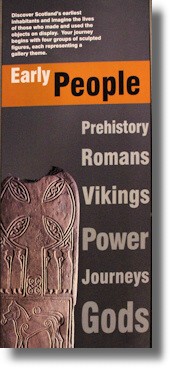
Places to Visit in Scotland - National Museum of Scotland
- Prehistory, Early Scots and Later Invaders

The museum starts the story of Scotland in geological times, showing the origins of the Scottish landscapes and rocks and the earliest animals which colonised the seas and the land.
Prehistory

The exhibits explore the origin and evolution of Scotland's landscape over millions of years. There are illustrations from rocks and fossils and displays showing how early life might have looked long before humans arrived on these shores. There are examples of Lewisian gneiss rocks which formed 3 billion years ago and fossils such as "Westlothiana lizzae" found in West Lothian in 1984 which is possibly the earliest known reptile.Some of the fossils were discovered by the pioneering Scottish geologist Hugh Miller who made important discoveries about the age of the earth.
The Earliest Scots


We do not know what the earliest Scots looked like - they left no representations of themselves in stone or paper. So it was a masterstroke to ask a sculptor, Eduardo Paolozzi, to create a modern representation of the human form and use these to display the artefacts and jewellery of these ancient people. Thus jewellery and artefacts from several thousand years ago were displayed inside modern sculpture. And the fact that Eduardo was born in nearby Leith (son of a local Italian shopkeeper) made it particularly appropriate.
The Romans


There is evidence that the Romans advanced as far north as Aberdeenshire but they retreated to establish themselves behind the Antonine Wall which stretched from the Rivers Clyde to the Forth. Roman coins were nevertheless in abundance - the ones illustrated here were found near Falkirk. Roman silver treasure from Traprain Law in East Lothian and was left there around 400AD. It is likely that it was given to a local chief to encourage him to remain loyal to the Romans at a time when their influence was crumbling. Roman remains are still being uncovered. This lion, apparently devouring a man, was found in 1998 in the River Forth, near the Edinburgh suburb of Cramond.
The Picts
The earliest known inhabitants of the Highlands of Scotland were called the "Picti" or "painted people" by a Roman writer round about 300AD.
Apart from late lists of kings written in Latin, they left no written record so we do not even know the name by which they called themselves. The stone carving on the left is one of the few surviving representations of the Picts. It clearly shows a drunken warrior, probably heading homewards. The comical unflattering tone of the carving is unusual
They are thought to have originated as Celts in central Europe and, as Bronze and Iron Age settlers, moved into the area after the ice age. In addition to the Highlands, including the Hebrides, the Picts spread into Angus and Fife as far as the river Forth.

They built forts and left many carved standing stones with symbols as well as narrative stories and representations of mounted warriors.
A few items of gold and silver jewellery have survived and some antler combs. None of their weapons have survived - only representations carved in stone. Later carved stones had Christian symbols on one side and narrative scenes and symbols on the other.
The Picts were eventually overcome by the Scots from Dalriada (that is, in Argyll in the west) who themselves were under pressure from the Vikings. Kenneth mac Alpin may have defeated the Picts in battle but around the 9th century they disappear from the historical records.
Many of the Pictish carved stones are large and impressive, such as this one found at Cadboll in Easter Ross. On the one side is a Christian cross, and on the other are secular depictions (see illustration here). Below the often used Pictish symbols of crescent and v-rod and double disc and Z-rod are a hunting scene including a woman wearing a large penannular brooch riding side-saddle. Like other similar stones, it can be dated between the 6th to 9th centuries.
The Vikings
Starting around 790AD, invaders from Scandinavia, travelling in their distinctive long ships spread across many areas and occupied the northern and western isles of Scotland and south to the Isle of Man and even established a colony in what is now Dublin in Ireland. Although their reputation is of fierce, violent warriors, they also became settlers in the land they conquered and they have left their mark in the genetic and cultural heritage, particularly in place names. A remarkable Viking relic was uncovered in Lewis - chessmen carved from bone and some of these are displayed in the Museum of Scotland. See also Did You Know - Lewis Chessmen.
More Pages on the Museum of Scotland
Return to the Main Index of Places to Visit
Where else would you like to go in Scotland?

